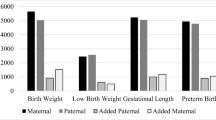Abstract
Objective
To ascertain the component of the excess preterm birth (< 37 weeks, PTB) rate among US-born (compared to foreign-born) Black women attributable to differences in acknowledged father’s education attainment.
Methods
Stratified analyses and Oaxaca-Blinder decomposition methods were performed on the 2013 National Center for Health Statistics birth certificate files of singleton infants with acknowledged fathers.
Results
US-born Black women (N = 196,472) had a PTB rate of 13.3%, compared to 10.8% for foreign-born Black women (N = 51,334; Risk Difference (95% confidence interval) = 2.5 (2.3, 2.8). Infants of US-born black women had a greater a percentage of fathers with a high school diploma or less and a lower percentage of fathers with bachelor’s degrees or higher than their counterparts of foreign-born women. In both subgroups, PTB rates tended to decline as the level of paternal education attainment rose. In an Oaxaca model (controlling for maternal age, education, marital status, parity, adequacy of prenatal care utilization, and chronic medical conditions), differences in paternal education attainment explained 15% of the maternal nativity disparity in PTB rates. In contrast, maternal education attainment accounted for approximately 4% of the disparity in PTB rates.
Conclusions for Practice
Acknowledged father’s low level of education attainment, or something closely related to it, explains a notable proportion of the disparity in PTB rates between US-born and foreign-born Black women.
Similar content being viewed by others
References
Alio, A., Kornosky, J., Mbah, A., Marty, P., & Salihu, H. (2010). The impact of paternal involvement on feto-infant morbidity among Whites, Blacks and Hispanics. Maternal and Child Health Journal, 14, 735–741.
Alio, A., Mbah, A., Kornosky, J., Wathington, D., Marty, G., & Salihu, H. (2011). Assessing the impact of paternal involvement on racial/ethnic disparities in infant mortality rates. Journal of Community Health, 36, 63–68.
Blinder, A. (1973). Wage discrimination: Reduced form and structural estimates. The Journal of Human Resources., 8, 436–455.
Blumenshine, P. M., Egerter, S. A., Libet, M. L., & Braveman, P. A. (2011). Father’s education: An independent marker of risk for preterm birth. Maternal and Child Health Journal, 15, 60–67.
Centers for Disease Control and Prevention (CDC). 2018. Preterm birth. Retrieved June 28, 2020 from http://www.cdc.gov/reproductivehealth/maternalinfanthealth/pretermbirth.htm.
Collins, J., Wu, S., & David, R. (2002). Differing intergenerational birth weights among the descendants of US-born Whites and African-Americans in Illinois. American Journal of Epidemiology, 155, 210–216.
David, R., & Collins, J. (1997). Differing birth weight among infants of U.S.-born blacks, African-born blacks, and U.S.-born whites. The New England Journal of Medicine, 337, 1209–1214.
David, R., & Collins, J. (2014). Layers of inequity: Power, policy and health. American Journal of Public Health, 104, S8–S10.
DeSisto, C., Hirai, A., Collins, J., & Rankin, K. (2018). Deconstructing a disparity: Explaining excess preterm birth among U.S.-born black women. Annals of Epidemiology, 28, 225–230.
DiPrete, T., & Buchmaan, C. (2014). Gender disparities in educational attainment in the new century: Trends, causes, and consequences. In J. Logan (Ed.), Diversity & disparities: America enters a new century. New York: Russell Sage Foundation.
Dominguez, T., Strong, E., Krieger, N., Gillman, M., & Rich-Edwards, J. (2009). Differences in the self-reported racism experiences of US-born and foreign-born Black pregnant women. Social Science and Medicine, 69, 258–265.
Elo, I., Vang, Z., & Culhane, J. (2014). Variation in birth Outcomes by mother’s country of birth among Non-Hispanic Black women in the United States. Maternal and Child Health Journal, 18, 2371–2381.
Green, T. (2012). Black and immigrant: Exploring the effects of ethnicity and foreign-born status on infant health. Washington, D.C.: Migration Policy Institute.
Hargraves, J., & Hadley, J. (2003). Impact of health care context: The contribution of insurance coverage and community resources to reducing racial/ethnic disparities in access to care. Health Services Research., 38, 809–829.
Howard, D., Marshall, S., Kaufman, J., & Savitz, D. (2006). Variations in low birth weight and preterm delivery among blacks in relation to ancestry and nativity: New York City, 1998–2002. Pediatrics, 118(5), e1399–e1405.
Jann, B. (2008). The blinder-Oaxaca decomposition for linear regression models. Stata Journal, 8, 453–479.
Kotelchuk, M. (1994). The adequacy of prenatal care utilization index: It’s US distribution and association with low birth weight. American Journal of Public Health., 84, 1486–1489.
Martin, J. A., Hamilton, B. E., Osterman, M. J., Curtin, S. C., & Matthews, T. J. (2015). Births: Final data for 2013. Natl Vital Stat Rep., 64, 1–65.
O’Donnell, O., van Doorslaer, E., Wagstaff, A., & Lindelow, M. (2007). Explaining differences between groups: Oaxaca decomposition. Analyzing health equity using household survey data: A guide to techniques and their implementation (pp. 147–157). Washington, D.C.: World Bank Group.
Oaxaca, R. (1973). Male-female wage differentials in urban labor markets. International Economic Review., 14(3), 693–709.
Pallotto, E., David, R., & Collins, J. (2000). Enigma of maternal race and infant birth weight: A population-based study of US-born Black and Caribbean-born Black women. American Journal of Epidemiology, 151, 1080–1085.
Waldfogel, J., Craigie, T.-A., & Brooks-Gunn, J. (2010). Fragile families and child wellbeing. The future of children. Center for the Future of Children, the David and Lucile Packard Foundation, 20, 87–112.
Wingate, M., & Alexander, G. (2006). The healthy migrant theory: Variations in pregnancy outcomes among US-born migrants. Social Science and Medicine, 62, 491–498.
Woodbridge, J. (2010). Linear probability model for binary response. In D. Wood (Ed.), Econometric analysis of cross section and panel data (2nd ed.). Cambridge, MA: MIT Press.
Author information
Authors and Affiliations
Corresponding author
Additional information
Publisher's Note
Springer Nature remains neutral with regard to jurisdictional claims in published maps and institutional affiliations.
Rights and permissions
About this article
Cite this article
Ekeke, P., Rankin, K., DeSisto, C. et al. The Excess Preterm Birth Rate Among US-Born (Compared to Foreign-Born) Black Women: The Role of Father’s Education. Matern Child Health J 26, 845–852 (2022). https://doi.org/10.1007/s10995-020-03117-9
Accepted:
Published:
Issue Date:
DOI: https://doi.org/10.1007/s10995-020-03117-9




